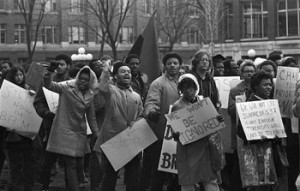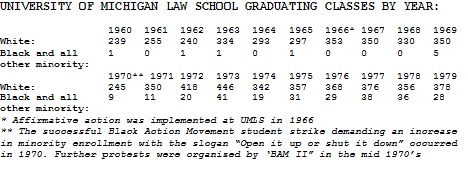The Fight for Integration & Equality
“You do not wipe away the scars of centuries by saying: Now you are free to go where you want, and do as you desire, and choose the leaders you please. You do not take a person who, for years, has been hobbled by chains and liberate him, bring him up to the starting line of a race and then say, ‘you are free to compete with all the others,’ and still justly believe that you have been completely fair…This is the next and the more profound stage of the battle for civil rights. We seek not just freedom but opportunity. We seek not just legal equity but human ability, not just equality as a right and a theory but equality as a fact and equality as a result…To this end equal opportunity is essential, but not enough, not enough.” -President Lyndon Johnson, 1965
art by Liana Mulholland
twitter: @lianamulholland
Only Independent Mass Action by Latina/o, black and Native American students and their allies can win full equality and integration
Opponents of affirmative action aim to eliminate the only social policies that have been an effective counterweight to the racism and sexism of our society – the only social policies that have achieved some measure of integration in higher education and employment.

Affirmative action, along with other social policies and programs designed to remedy the segregation and inequality of American society, arose out of the civil rights struggles and urban rebellions of the 1960’s. The contradiction between the newly achieved steps in the direction of equality before the law in the 1960’s and the persisting stark inequality in both northern and southern states between black and white was the material context for the implementation of affirmative action.
Integration and equality are inseparable. The degree to which they have been achieved measures the real progress and the real democracy of the nation.
Before the implementation of affirmative action, graduate and professional schools (excluding Historically Black Colleges and Universities) were almost all white, and overwhelmingly male. The chart below from the trial of Grutter makes clear that in the absence of race-conscious admissions policies – there exists de facto segregation. The dates that punctuate a rise in black enrollment also make clear that only independent mass action led by black students forced the implementation of these policies.
Between 1950 and 1970, the University of Michigan Law School graduated 5,573 people. Of these graduates, 5,543 were white, 30 were black, and none were Latino/a, Asian American, or Native American. These figures stand in stark contrast to the demographics of the 2000 entering class of the University of Michigan Law School which was composed of 28% minority students.
 – From the Trial Testimony of Professor John Hope Franklin, one of the nation’s premiere scholars on black history and expert witness for the student defendant intervenors in the University of Michigan Law School affirmative action case, Grutter v. Bollinger. For more from John Hope Franklin’s testimony, see Trial Transcript Vol. 7 – www.umich.edu/~daap/facts.htm
– From the Trial Testimony of Professor John Hope Franklin, one of the nation’s premiere scholars on black history and expert witness for the student defendant intervenors in the University of Michigan Law School affirmative action case, Grutter v. Bollinger. For more from John Hope Franklin’s testimony, see Trial Transcript Vol. 7 – www.umich.edu/~daap/facts.htm
Affirmative action programs opened up educational opportunities for all minorities and women of all races.
Between 1890 and 1970, the percentage of lawyers who were black increased less than one percentage point: from 0.48% to 1.29%. Fifteen years later, in response to the urban uprisings of the 1960’s and militant mass actions by black and Latina/o students on campuses across the nation, 5.1% of law students were black. In 1995, the last year affirmative action programs existed at every law school, black students comprised 7.5% of all law students. In 1960, a tiny number of all law students were women; today, just over 50% of law students are women. In 1971, women received 6.3% of all professional degrees. Ten years later, the figure had more than quadrupled to 27.5%.
Conversely, after the ban on affirmative action in California the number of women faculty decreased by 22% throughout the UC system. The first year that affirmative action was banned in California, 808 black, Latina/o and Native American students with a 4.0 GPA and SAT scores over 1200 were rejected from UC Berkeley. Last year, only 4 Black and 4 Latino students from the entire Oakland Unified School District were admitted to UC Berkeley or UCLA.
Racism is a reality. Sexism is a reality. As long as racism and sexism exist, we need active policies like affirmative action of offset the damage and disadvantage they create. OVERTURN PROP 209!!!
